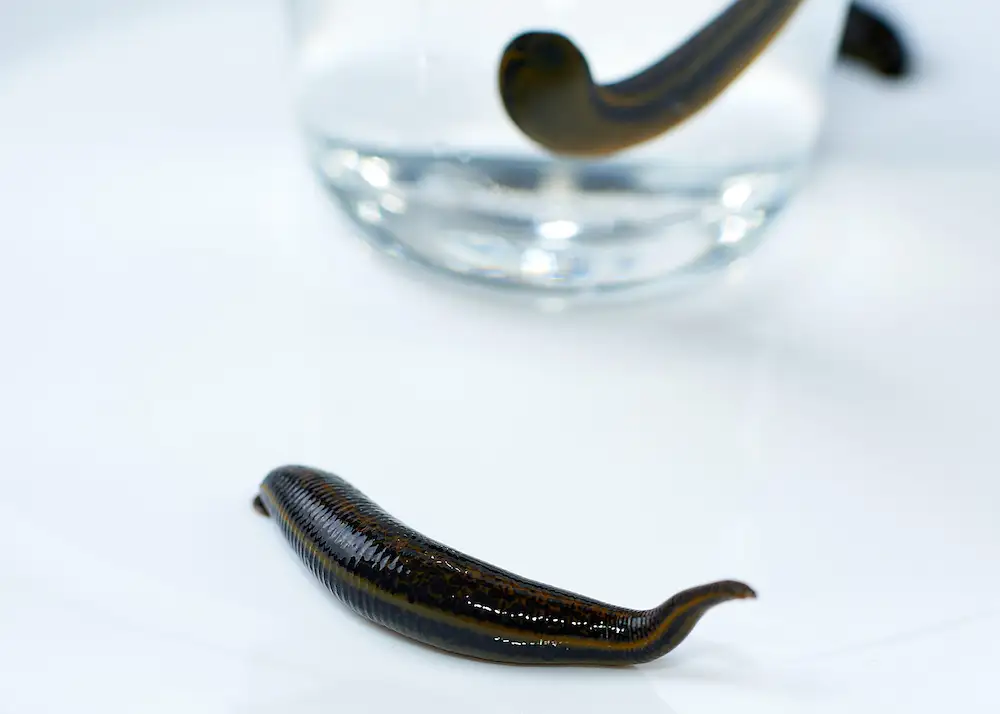Acne vulgaris is a chronic, non-infectious disease of the hair follicles and sebaceous gland openings. It is one of the most common dermatological conditions, mainly affecting adolescents, though not exclusively. Acne vulgaris is characterized by both non-inflammatory and inflammatory lesions. There are many ways to treat acne vulgaris, with leeches being one of the more effective methods. Why should leeches be applied for acne? We answer!
Acne vulgaris – what is it?
Acne vulgaris is one of the most common skin diseases. It is chronic and non-infectious. It results from excessive sebaceous gland activity and is characterized by skin changes.
Acne vulgaris is often called teenage acne, as most cases of the disease affect teenagers during puberty. However, acne is increasingly becoming a problem for adults – there is a rise in incidences among people between the ages of 20 and 40.
Types of acne
Acne is classified into different types depending on the severity of acne, the type of lesions, and the reasons for their occurrence. These include:
– Mild forms – comedonal (non-inflammatory) acne, papular acne, papulopustular (inflammatory) acne,
– Moderate forms – nodular acne and papulopustular acne,
– Severe forms – conglobate acne, fulminant acne, acne with scarring, pyoderma faciale, hidradenitis suppurativa, nodulocystic acne,
– Other types of acne are adult acne, cosmetic acne, drug-induced acne, occupational acne, infantile acne, and excoriated acne.
Causes of acne vulgaris
It is difficult to pinpoint a single cause of acne. The aetiology of the condition is multifactorial. Among the reasons for the occurrence of acne vulgaris are:
– Genetic predispositions,
– Hyperplasia of sebaceous glands and excessive sebum production,
– Hormonal changes during puberty,
– Excessive keratinization at the openings of hair follicle units,
– The process of conidiogenesis,
– The influence of bacteria and yeasts,
– The use of certain cosmetics,
– Taking certain medications.
Symptoms of acne vulgaris
The most typical symptom, which suggests acne vulgaris, is the presence of comedones in the skin. There are two types of comedones: open, with patent sebaceous gland openings, and closed, with blocked sebaceous gland openings. Open comedones, commonly called blackheads, are dark in colour, whereas closed comedones are small, raised spots with a slightly yellowish colour.
Symptoms of acne vulgaris include:
– Non-inflammatory changes – micro comedones transforming into closed comedones,
– Inflammatory changes – papules, nodules, pustules, cysts, and inflammatory infiltrates,
– Post-inflammatory changes – hyperpigmentation, atrophic scars, hypertrophic scars, keloids.
General symptoms such as elevated temperature may also occur sometimes. The course of the disease is chronic, with acne lesions appearing somewhat better during the summer.
Acne lesions are primarily located on the face. However, some individuals may also appear on the shoulders, chest, and back, i.e., areas with the highest concentration of sebaceous glands.
Diagnosis of acne vulgaris
In diagnosing acne lesions, the doctor uses subjective and objective examinations, primarily considering the type and location of skin lesions. In adolescents, body height and weight, as well as growth patterns, are taken into account.
Identifying the direct cause of acne is crucial. Therefore, appropriate laboratory tests are necessary. The most commonly ordered are complete blood count with differential, blood glucose levels, lipid profile, total cholesterol, LDL and HDL fractions and triglycerides, and specific hormone levels. The dermatologist decides which tests to perform based on the patient’s health condition.
Treatment of acne vulgaris
Treating acne vulgaris is not only long and tedious but also not always satisfactory – often, post-inflammatory hyperpigmentation and scars are left on the skin. In mild forms of acne vulgaris, mainly topical medications are used along with proper skin care, while in more severe cases, specialized and general treatments are implemented. Topical therapies include antibiotics (e.g., clindamycin, erythromycin, tetracycline), azelaic acid, or retinoids. In more severe conditions, patients take antibiotics, especially tetracyclines and anti-androgen medications.
Leeches for acne vulgaris
Leeches have been scientifically confirmed to be an effective method for treating acne. Researcher S. S. Deshmukh conducted a study involving 80 individuals suffering from acne. They were divided into four groups of 20 and treated differently depending on the group:
– Group I received leech therapy,
– Group II underwent leech therapy along with oral and topical anti-acne agents,
– Group III used leeches and antibiotics for treatment,
– Group IV was treated with modern techniques, including antibiotics.
Leeches alone proved to be the fastest and most effective treatment method—they reduced pain and tenderness. In all patients who underwent leech therapy, the redness disappeared, while in those treated only with antibiotics, the restoration of proper skin colour took twice as long.
The study showed that leeches also work on acne scars. The best results were obtained by combining leech therapy with oral and topical anti-acne agents.

